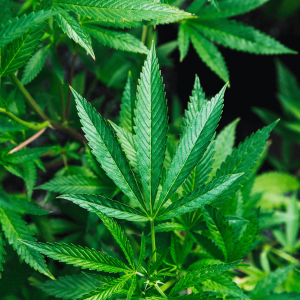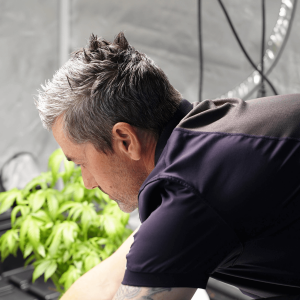If cannabis ruderalis is on your radar, then today is your lucky day because we’re taking a deep dive into this underdog of the cannabis plant family.
This scrappy subspecies of wild cannabis thrives in the harshest climates of central and eastern Europe and Russia, giving it some serious street cred in the world of weed. With its ability to flower independently of light cycles, ruderalis plants are the rebel cousins that stand out from the crowd of other indica and sativa varieties.
Today, we’ll uncover everything you need to know about this unsung hero, including its historical exploits, unique traits, and how it’s shaking up the cannabis industry. Let’s begin!
Botanical Features of Cannabis Ruderalis Plants
The botanical features of cannabis ruderalis set it apart from its better-known relatives and these unique characteristics allow it to survive and thrive in harsh conditions.
Growth Structure
Cannabis ruderalis plants are usually on the smaller side, reaching about 1 to 2.5 feet tall. Their short and sturdy structure is a smart adaptation to tough climates. This compact plant can handle windy conditions and grows quickly, allowing it to reproduce before winter hits.
Leaves and Stems
The leaves of cannabis ruderalis are usually smaller and wider compared to other cannabis subspecies like cannabis indica or cannabis sativa. They have a deep, lush green color that helps them thrive even in low-light conditions. The stem, though slender, is surprisingly strong and can handle tough environmental conditions.
Reproductive System
One of the coolest things about cannabis ruderalis is its ability to flower on its own, known as auto-flowering. Instead of relying on light cycles, it transitions from the growth phase to the flowering phase based on its maturity. This unique trait helps cannabis ruderalis thrive in unpredictable weather conditions, ensuring its survival and propagation.
Geographic Distribution
Cannabis ruderalis has quite an impressive geographical footprint that can be broken down into three main topics:
- Native Regions: Cannabis ruderalis originates from central and eastern Europe, and parts of Russia. Despite the crazy weather in those areas, this tough cannabis species has managed to thrive and spread.
- Environmental Adaptations: Cannabis ruderalis is a true survivor. Its unique adaptations, like auto-flowering, compact growth, and sturdy stems, help it withstand tough conditions, from crazy winds to low light levels.
- Global Spread: Over time, cannabis ruderalis has made its way around the world. Breeders have used its special traits to create hybrid strains that can handle different climates. From freezing Siberia to North America’s mild zones, cannabis ruderalis is a global sensation.

Cannabinoid Profile: THC and CBD Content
Cannabis ruderalis has a unique cannabinoid profile compared to the more common cannabis subspecies.
For starters, it usually has lower levels of Tetrahydrocannabinol (THC), which is the primary psychoactive compound in cannabis. In other words, it’s the cannabinoid that actually gets you high.
While that might not be great news for stoners looking for a recreational buzz, it’s actually a major win for those who want the therapeutic benefits without the psychoactivity.
But here’s the cool part: Cannabis ruderalis tends to have higher levels of Cannabidiol (CBD), which is a non-psychoactive compound known for its potential healing properties. So, with more CBD and less THC, Cannabis ruderalis is a pretty attractive choice for medicinal use.
Speaking of which…
Medicinal Potential of Cannabis Ruderalis
Cannabis ruderalis is quickly gaining popularity in the medical marijuana community because of its medicinal properties and its great potential for therapeutic use.
With its high CBD and low THC content, it’s a great option for medical marijuana users who want to experience the health benefits of cannabis without the mind-altering effects. Early research shows it could even be helpful for conditions like chronic pain, inflammation, anxiety, and epilepsy.
Comparison with Other Cannabis Varieties
When compared with other cannabis species like Cannabis sativa and Cannabis indica, Cannabis ruderalis offers several unique advantages.
For example, the auto-flowering trait of Cannabis ruderalis makes it more adaptable and easier to cultivate, particularly in regions with unpredictable or harsh weather conditions. Additionally, its lower THC and higher CBD content make it particularly interesting to medical users and breeders.
These unique features not only make this subspecies stand out but also contribute to its growing significance in the ever-changing world of cannabis cultivation and consumption.
Cultivating Cannabis Ruderalis Plants
As we dig deeper into the world of cannabis ruderalis, it’s time to explore a crucial aspect that sets it apart: growing these tough cannabis plants.
With their resilience and unique characteristics, cultivating cannabis ruderalis offers a different perspective compared to its cousins, cannabis sativa and cannabis indica. But let’s take a closer look.

Growing Conditions
Cannabis ruderalis is pretty amazing when it comes to adapting and surviving in different growing conditions.
Unlike its relatives, this tough plant can handle rough environments and unpredictable weather like a champ. Plus, it grows crazy fast, going from seed to harvest in just 8 to 10 weeks.
But that’s not all. Another major advantage to growing cannabis ruderalis is that it’s not as bothered by pests and diseases, making it perfect for newbie growers. With that being said, we’d say it’s a solid choice all around!
Challenges and Benefits
Despite its robust nature, cultivating Cannabis ruderalis is not without challenges. Its small size may lead to lower yields when compared to larger cannabis plants, and its lower THC content might be seen as a downside by some cultivators seeking a high psychoactive output.
However, the perks of growing this tough plant usually outweigh the hurdles. With its auto-flowering trait, you can say goodbye to light cycle management and make the growing process a breeze. Plus, the high CBD content opens up possibilities for producing CBD-rich products with therapeutic benefits.
Breeding and Hybridization
The unique traits of cannabis ruderalis have revolutionized the world of cannabis breeding.
Breeders are increasingly crossing this species with its high THC relatives to create ruderalis hybrids that retain the auto-flowering trait and hardiness of cannabis ruderalis while increasing the THC content.
These hybrids combine the best of both worlds, resulting in strains that are easy to grow, resilient, and have a balanced cannabinoid profile. By doing so, Cannabis ruderalis is shaping the future of cannabis cultivation, proving that sometimes, the underdog does indeed come out on top.
Uses and Applications of Cannabis Ruderalis Strains
In the vast and diverse world of cannabis, ruderalis strains have carved out a unique niche for their notable characteristics and applications.
Next up, we’ll take a closer look at the countless ways these strains are used and applied. We’ll explore their roles in different areas, from medicine to having a good time, and even how they impact horticulture.
- Traditional Uses: In the past, Cannabis ruderalis wasn’t as widely used for recreational or medicinal purposes because it had low THC content. However, it was actually quite handy for practical stuff like making strong ropes and textiles from its sturdy stem. People even ate the seeds for their nutritional benefits.
- Contemporary Applications: These days, Cannabis ruderalis is gaining popularity for its high CBD and low THC content, making it a great choice for therapeutic purposes. Its unique properties have led to the development of many CBD-rich products that don’t get you high, but are said to have potential health benefits. It’s also been used to breed new cannabis strains that combine the auto-flowering and resilient qualities of ruderalis with the stronger THC content of other varieties.
- Industrial Potential: The industrial potential of Cannabis ruderalis is vast. Beyond its use in the medical field, it’s also being explored for its potential to produce biofuel due to its rapid and robust growth. Plus, its tough fibers are still an excellent resource for the production of textiles and building materials, making it a sustainable, eco-friendly alternative to conventional materials.

Summary
To wrap it up, Cannabis ruderalis is seriously impressive. With its high CBD, low THC, and ability to grow quickly, it’s perfect for medical use, breeding, and even making cool hybrid cannabis strains with ruderalis genetics. Plus, it’s tough as nails and can resist pests.
From biofuels to textiles and even building materials, this plant can do it all. The future of Cannabis ruderalis looks bright as breeders keep finding new ways to make awesome strains.
As we continue to explore and understand this amazing plant, one thing’s for sure: it’s a total game-changer in the world of cannabis. So many possibilities and opportunities lie ahead and we can’t wait to see what happens next!
Frequently Asked Questions
1. Does ruderalis make you high?
Cannabis ruderalis typically has a low THC content, which is the compound responsible for the psychoactive effects or “high” associated with cannabis. Therefore, ruderalis strains on their own are less likely to produce a significant high compared to Cannabis sativa or Cannabis indica.
2. Is ruderalis legal to grow?
The legality of growing a ruderalis plant depends on local laws and regulations. In areas where cannabis cultivation is legal, it’s typically legal to grow most pure ruderalis strains. However, in regions where cannabis cultivation is not permitted, it remains illegal regardless of the strain. Always check your local regulations before starting cultivation.
3. What’s the difference between ruderalis and indica?
Ruderalis and Indica are two different subspecies of cannabis. Ruderalis is known for its auto-flowering trait, ability to withstand harsh conditions, smaller size, and lower THC content. On the other hand, cannabis indica is usually larger, requires specific light cycles to flower, and typically has a higher THC content.
4. Can ruderalis have 7 leaves?
Yes, Ruderalis can have seven leaflets per leaf, although it’s more common to see fewer leaflets. The number of leaflets can vary widely and is influenced by various factors such as the plant’s age, overall health, and genetic makeup.

 Rewards
Rewards





